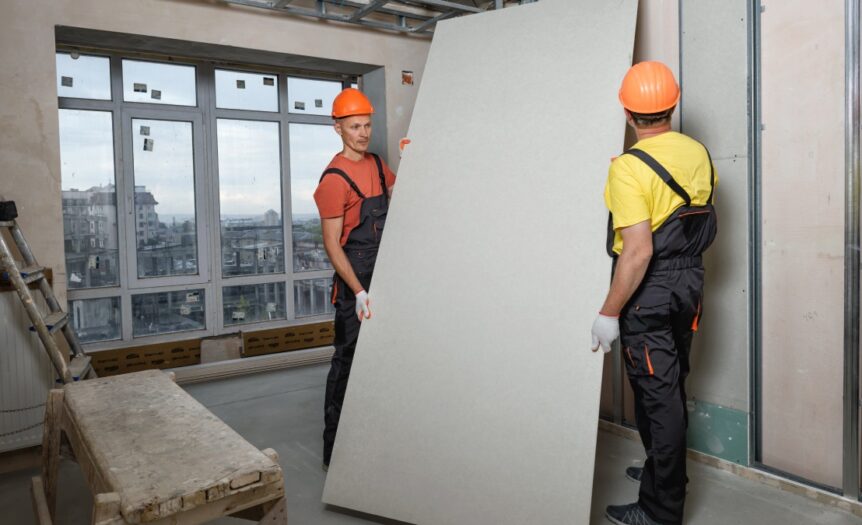Drywall installation is a common practice in construction and home renovation, and it’s known for its effectiveness in creating smooth walls and ceilings. While it may seem straightforward, installers and homeowners need to be aware of hidden dangers, including health risks associated with handling drywall dust and potential structural issues caused by improper installation techniques.
Let’s look at the hidden dangers of drywall installation and how you can address them for a safe and successful project.
Health Risks of Drywall Dust
One of the most significant dangers of drywall installation is the production and spread of dust. When cutting and sanding drywall, tiny particles enter the air that can pose health risks if inhaled. These particles can contain various materials, such as gypsum, silica, talc, and mica, which could cause respiratory issues when inhaled. If workers don’t protect themselves, they could suffer long-term health problems such as lung disease or cancer.
To avoid these risks, follow safety guidelines set by the Occupational Safety and Health Administration (OSHA). This includes using dust-reducing tools, wearing personal protective equipment, and implementing ventilation systems to control dust levels on the job site.
Structural Concerns From Poor Installation Techniques
While drywall installation may seem simple, it requires skill and precision for a durable and safe result. Poor installation techniques can lead to significant structural concerns that impact the integrity of a building. For example, if you don’t place drywall nails or screws at the correct depth or spacing, cracks may form in walls and ceilings over time. Similarly, improperly sealing joints between drywall panels can result in moisture ingress, causing mold growth and weakening the structure.
To prevent these issues, hire experienced and trained professionals for drywall installation. They have the knowledge and expertise to handle various types of drywall materials, use proper techniques to secure them, and seal all joints.
Fire Hazards
Another hidden danger of drywall installation is flammability. While gypsum-based boards used for drywall are fire-resistant, they are not entirely fireproof. Improperly installed or damaged drywall can expose the flammable materials behind it, increasing the risk of a fire spreading quickly through a building. Additionally, incorrectly installed electrical wiring can lead to electrical fires.
To mitigate these hazards, follow local building codes and regulations for fire-rated drywall installation. This involves regularly inspecting and maintaining electrical wiring to ensure it meets safety standards.
Drywall installation comes with hidden dangers that you cannot ignore. Some of the questions to ask your drywall contractor are about the potential risks and how they take precautions to ensure a safe and successful installation. Remember to prioritize safety and quality in your drywall installation project for a durable and long-lasting result.










 Deering Estate
Deering Estate
 Massage Envy South Miami
Massage Envy South Miami
 Calla Blow Dry
Calla Blow Dry
 My Derma Clinic
My Derma Clinic
 Sushi Maki
Sushi Maki
 Sports Grill
Sports Grill
 The Healthy Kitchen
The Healthy Kitchen
 Golden Rule Seafood
Golden Rule Seafood
 Malanga Cuban Café
Malanga Cuban Café

 Kathleen Ballard
Kathleen Ballard
 Panter, Panter & Sampedro
Panter, Panter & Sampedro
 Vintage Liquors
Vintage Liquors
 The Dog from Ipanema
The Dog from Ipanema
 Rubinstein Family Chiropractic
Rubinstein Family Chiropractic
 Your Pet’s Best
Your Pet’s Best
 Indigo Republic
Indigo Republic




 ATR Luxury Homes
ATR Luxury Homes


 2112 Design Studio
2112 Design Studio
 Hamilton Fox & Company
Hamilton Fox & Company
 Creative Design Services
Creative Design Services
 Best Pest Professionals
Best Pest Professionals
 HD Tree Services
HD Tree Services
 Trinity Air Conditioning Company
Trinity Air Conditioning Company
 Cisca Construction & Development
Cisca Construction & Development
 Mosquito Joe
Mosquito Joe
 Cutler Bay Solar Solutions
Cutler Bay Solar Solutions


 Miami Royal Ballet & Dance
Miami Royal Ballet & Dance
 Christopher Columbus
Christopher Columbus
 Pineview Preschools
Pineview Preschools
 Westminster
Westminster
 Carrollton
Carrollton
 Lil’ Jungle
Lil’ Jungle
 Frost Science Museum
Frost Science Museum
 Palmer Trinity School
Palmer Trinity School
 South Florida Music
South Florida Music
 Pinecrest Orthodontics
Pinecrest Orthodontics
 Dr. Bob Pediatric Dentist
Dr. Bob Pediatric Dentist
 d.pediatrics
d.pediatrics
 South Miami Women’s Health
South Miami Women’s Health

 The Spot Barbershop
The Spot Barbershop
 My Derma Clinic
My Derma Clinic




 Miami Dance Project
Miami Dance Project

 Rubinstein Family Chiropractic
Rubinstein Family Chiropractic
 Indigo Republic
Indigo Republic

 Safes Universe
Safes Universe
 Vintage Liquors
Vintage Liquors
 Evenings Delight
Evenings Delight





 Atchana’s Homegrown Thai
Atchana’s Homegrown Thai
 Baptist Health South Florida
Baptist Health South Florida

 Laser Eye Center of Miami
Laser Eye Center of Miami
 Visiting Angels
Visiting Angels
 OpusCare of South Florida
OpusCare of South Florida

 Your Pet’s Best
Your Pet’s Best





 HD Tree Services
HD Tree Services
 Hamilton Fox & Company
Hamilton Fox & Company


 Creative Design Services
Creative Design Services